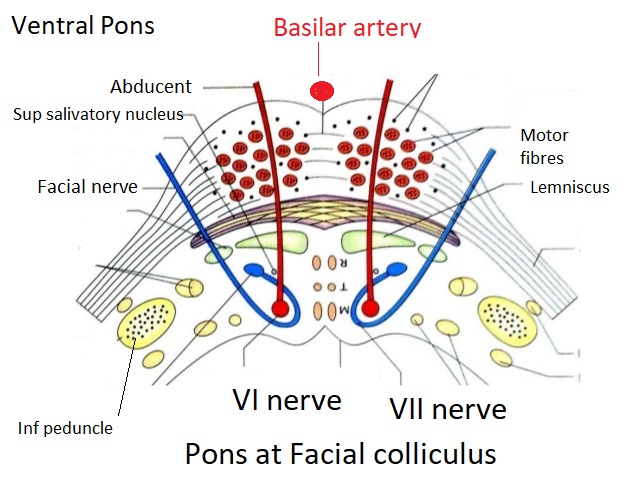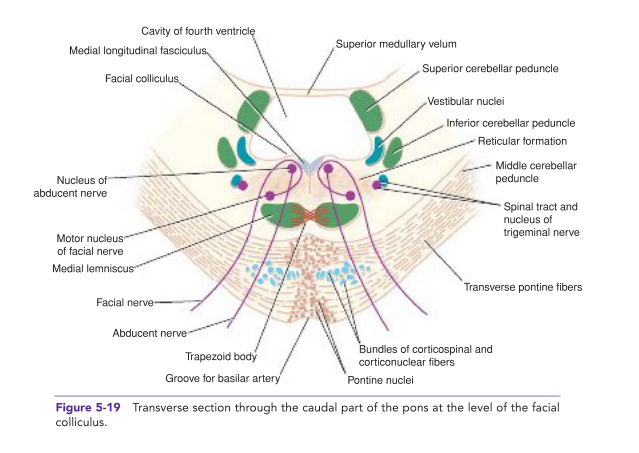Note that anatomical pictures of the pons are upside down compared with the CT/MRI except below
Overview of the Pons
The pons is a structure located in the brainstem, between the midbrain and the medulla oblongata. It serves as a critical relay station for messages between different parts of the brain and plays a significant role in several vital functions, including respiration, sleep regulation, and sensory and motor pathways.
Anatomy of the Pons
- Location and Structure:
- The pons is part of the brainstem and lies anterior to the cerebellum.
- It is composed of two main parts:
- Basal (Ventral) Pons: The anterior portion, which contains pontine nuclei and major descending motor tracts.
- Tegmentum (Dorsal Pons): The posterior portion, which contains ascending sensory tracts, cranial nerve nuclei, and the reticular formation.
Nuclei in the Pons
- Pontine Nuclei:
- Relay information from the cerebral cortex to the cerebellum, playing a crucial role in coordinating voluntary movements.
- Cranial Nerve Nuclei:
- The pons contains several cranial nerve nuclei, including:
- Trigeminal Nerve (CN V) Nuclei:
- Main Sensory Nucleus: Processes touch and pressure sensations from the face.
- Mesencephalic Nucleus: Processes proprioceptive information from the muscles of mastication.
- Motor Nucleus: Controls the muscles of mastication.
- Spinal Trigeminal Nucleus: Extends into the medulla and processes pain and temperature sensations from the face.
- Abducens Nerve (CN VI) Nucleus:
- Controls the lateral rectus muscle of the eye, allowing for lateral eye movement.
- Facial Nerve (CN VII) Nucleus:
- Motor nucleus controls the muscles of facial expression.
- Superior salivatory nucleus provides parasympathetic fibers to the salivary and lacrimal glands.
- Nucleus of the solitary tract (shared with CN IX and X) processes taste sensations from the anterior two-thirds of the tongue.
- Vestibulocochlear Nerve (CN VIII) Nuclei:
- Cochlear Nuclei: Process auditory information from the cochlea.
- Vestibular Nuclei: Process information about balance and spatial orientation from the vestibular apparatus.
- Other Important Nuclei:
- Pneumotaxic Center:
- Located in the upper pons, it regulates the rhythm of breathing by inhibiting the inspiratory phase, promoting a regular breathing pattern.
- Reticular Formation:
- Involved in maintaining arousal and consciousness, it extends through the central core of the brainstem.
Functions of the Pons
- Relay of Information:
- The pons acts as a bridge for signals between the cerebrum and cerebellum, as well as between the brain and spinal cord.
- Respiratory Control:
- The pneumotaxic centre in the pons helps regulate the rhythm of breathing.
- Sleep Regulation:
- The pons contains nuclei involved in the regulation of sleep and arousal, particularly in initiating REM sleep.
- Sensory and Motor Functions:
- Processes sensory information from the face and head through the trigeminal nerve nuclei.
- Controls facial expressions, mastication, eye movements, and hearing through its associated cranial nerve nuclei.
Clinical Relevance
- Pontine Strokes:
- Infarctions in the pons can lead to significant neurological deficits, including paralysis, sensory loss, and cranial nerve dysfunction.
- Locked-in Syndrome:
- A condition resulting from damage to the ventral pons, leading to quadriplegia and an inability to speak, while consciousness and eye movements remain intact.
- Acoustic Neuromas:
- Benign tumours on the vestibulocochlear nerve can affect the pons, leading to hearing loss, balance issues, and facial nerve dysfunction.
Summary
The pons is a vital structure within the brainstem that serves as a crucial relay centre for sensory and motor pathways, regulates breathing and sleep, and houses important cranial nerve nuclei. Understanding the anatomy and functions of the pons is essential for diagnosing and managing neurological conditions that impact this key area of the brain.

